
Poppy Ai: From one video to 20 posts In Minutes
Drop in a single clip and watch Poppy outline a blog, draft Shorts scripts, and build a caption bank. You keep your voice; Poppy handles the heavy lifting. It’s the simplest way to be around everywhere without actually having to spend all of your time online.
Friend to friend: a few links are affiliate links. When you purchase, I might get a tiny thank-you from the company, with zero added cost to you. I only recommend things that I’ve actually tried and looked into. Nothing here is financial advice; it is for entertainment. Read the full affiliate disclosure and privacy policy.
Replace hours, not judgment. In two weeks, see if Poppy can draft and repurpose enough content to beat your assistant budget—then keep humans for voice and approvals. Refund window covers the learning curve.
You’re here to answer a simple question: can Poppy cover the work you’d hire a junior marketing assistant to do every month… and save you real money?
In the U.S., junior assistants cluster around $3,400–$3,800 per month when you convert current hourly and salary data to monthly pay.
AI changes the math. Recent benchmarking finds the average AI-written post costs about $131, while human-written posts average $611—roughly 4.7× cheaper.
That cost gap fuels a practical, hybrid model: let AI draft and repurpose, then keep humans for voice, claims, and relationships.
So what is Poppy? A visual, “multiplayer” AI workspace built for creators and marketers. You co-create ideas, scripts, captions, and ad concepts on a shared canvas… with a 30-day money-back guarantee to de-risk your trial.
We’ll test whether that combo of collaboration and speed can stand in for a $3,000/month hire, where it excels, and where a human still leads.

What a $3,000/month marketing assistant covers vs what AI covers
Marketing assistants keep content moving. They research, draft, schedule, coordinate assets, update sites, and report results so managers can steer campaigns. The role spans admin and light creative work across email, social, and events.
Daily duties of a marketing assistant
Typical lists mention: coordinating campaigns, creating or editing marketing materials, updating websites, drafting captions, scheduling posts, organizing events, collecting feedback, and building simple reports.
Employers often expect cross-team support and solid admin hygiene.
Tasks Poppy can automate or accelerate
Poppy is positioned as a visual, collaborative “multiplayer” AI. In practice, that means shared canvases where teams ideate, outline, and generate drafts together using templates for posts, scripts, and ad concepts.
Common accelerators for assistants: topic ideation, caption variations, post calendars, copy drafts from briefs, headline testing, and repurposing a video into scripts and short-form copy.
Collaboration reduces back-and-forth because stakeholders can review and edit in the same space. – Poppy Ai
quick_win: Turn one approved pillar video into a blog outline, 5 short captions, and a hook bank in one canvas session. Review once, ship many.
Tasks to keep human-led
Brand voice QA, final approvals, stakeholder coordination, and nuanced outreach remain human. These rely on judgment, relationship context, and risk assessment beyond pattern generation.
Even vendor and JD materials imply assistants operate under manager guidance, which supports a hybrid model: AI drafts and compiles, humans validate and decide.
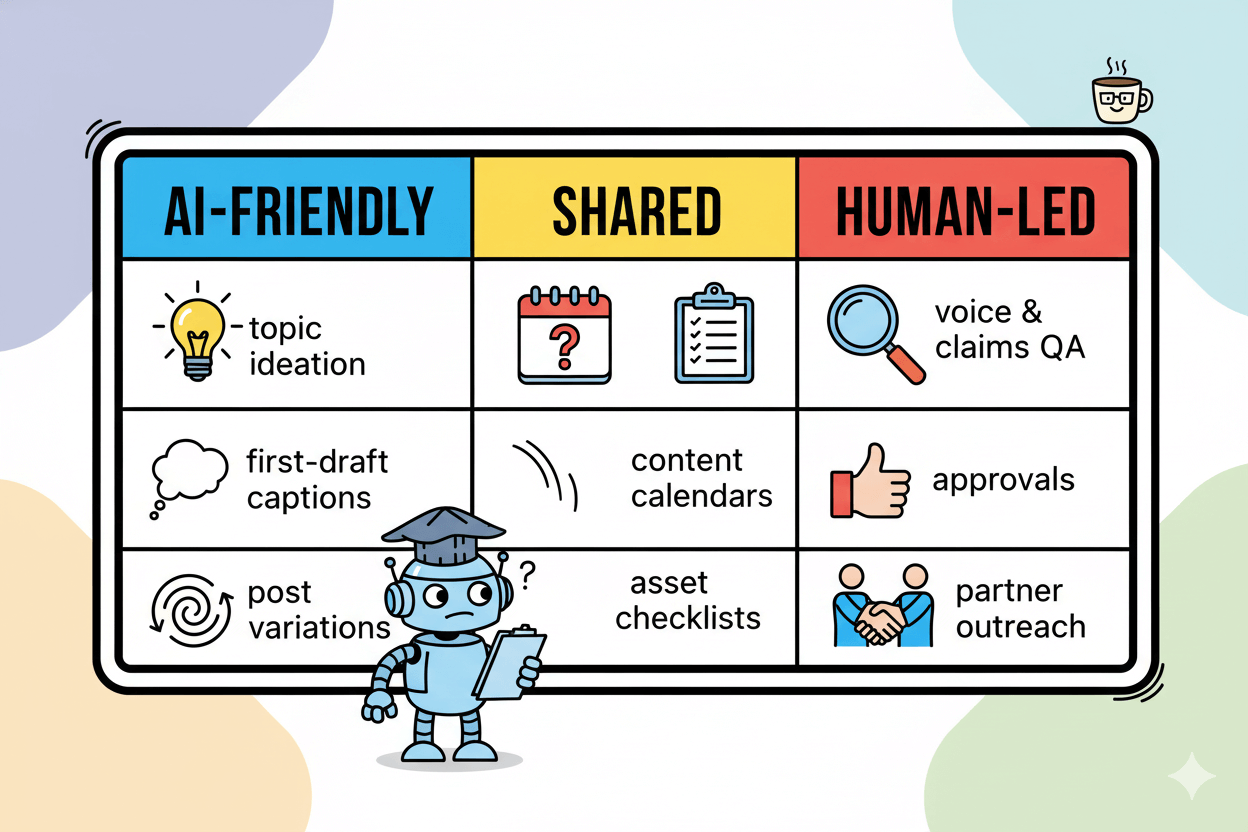
Current costs: salaries, tools, and Poppy pricing caps
Let’s put real numbers on the table. ZipRecruiter’s live aggregates peg U.S. marketing assistants at about $3,787 per month as of Oct 19, 2025. – ZipRecruiter
Indeed’s current average sits at $20.06/hour, which lands near $3,477 per month on a standard 40-hour week. Entry-level listings often run higher in monthly terms, with ZipRecruiter showing ~$4,131/month for “Entry Level Marketing Assistant.”
These anchors define the baseline a junior hire would cost before benefits, payroll taxes, or software.
Salary benchmarks and monthly conversions
Convert hourly to monthly for apples-to-apples comparisons. Use current hourly averages and standard 40-hour weeks to estimate your city’s monthly baseline, then adjust for benefits and taxes if hiring.
Poppy pricing signals and credit caps
The official site emphasizes a 30-day money-back guarantee; the refund policy requires booking and attending an onboarding call within that window to qualify.
Pricing and usage caps are lighter on the homepage, so rely on third-party reviews as signals only: plans “starting around $90/month” with ~1,000 credits/month; some community reports mention ~2,000 credits/month on higher tiers.
Confirm at checkout.
All-in monthly stack
If you’re comparing “hire vs. tool,” frame it simply:
- Human baseline: $3.5k–$3.8k/month for a junior assistant before overhead.
- AI-hub baseline: Poppy subscription + add-ons. Use the guarantee window to observe credit burn during a normal month of production. Heavy repurposing or long drafts may require a higher tier.
Pro tip. During the first 30 days, log every major action (ideation, outline, repurpose, export) against the credit meter and tag outputs that still need human polishing. That log becomes your cost curve and quality bar for a keep-or-cancel decision aligned to your content volume.
| Metric | Junior Hire (Salary Only) | Poppy Yearly Plan | Poppy Lifetime Deal |
|---|---|---|---|
| Monthly Cost | $3.5k–$3.8k/month | $399/annual | $997/one time payment |
| Usage Caps | No caps | Credit-based | Higher credit pool |
| Typical Outputs/Week | Varies by skill | High throughput | Higher throughput |
| Refund / Guarantee Policy | No refund | Yes, 30 day Guarantee | Yes, 30 day Guarantee |
What is Poppy AI and how it works
Poppy is a visual AI workspace built for content teams. Think infinite canvas plus AI operators that help you ideate, draft, and repurpose together.
The product pitch centers on “multiplayer AI” and a 30-day money-back guarantee to de-risk a pilot.
Multiplayer AI workspace and collaboration
“Multiplayer” here means simultaneous creation with AI inside the board. Marketers sketch hooks, beats, and CTAs while AI fills drafts or alternatives, and reviewers adjust tone or structure live.
Poppy’s marketing contrasts this with single-user, chat-only tools and highlights co-creation as the differentiator for campaigns and ad concepts.
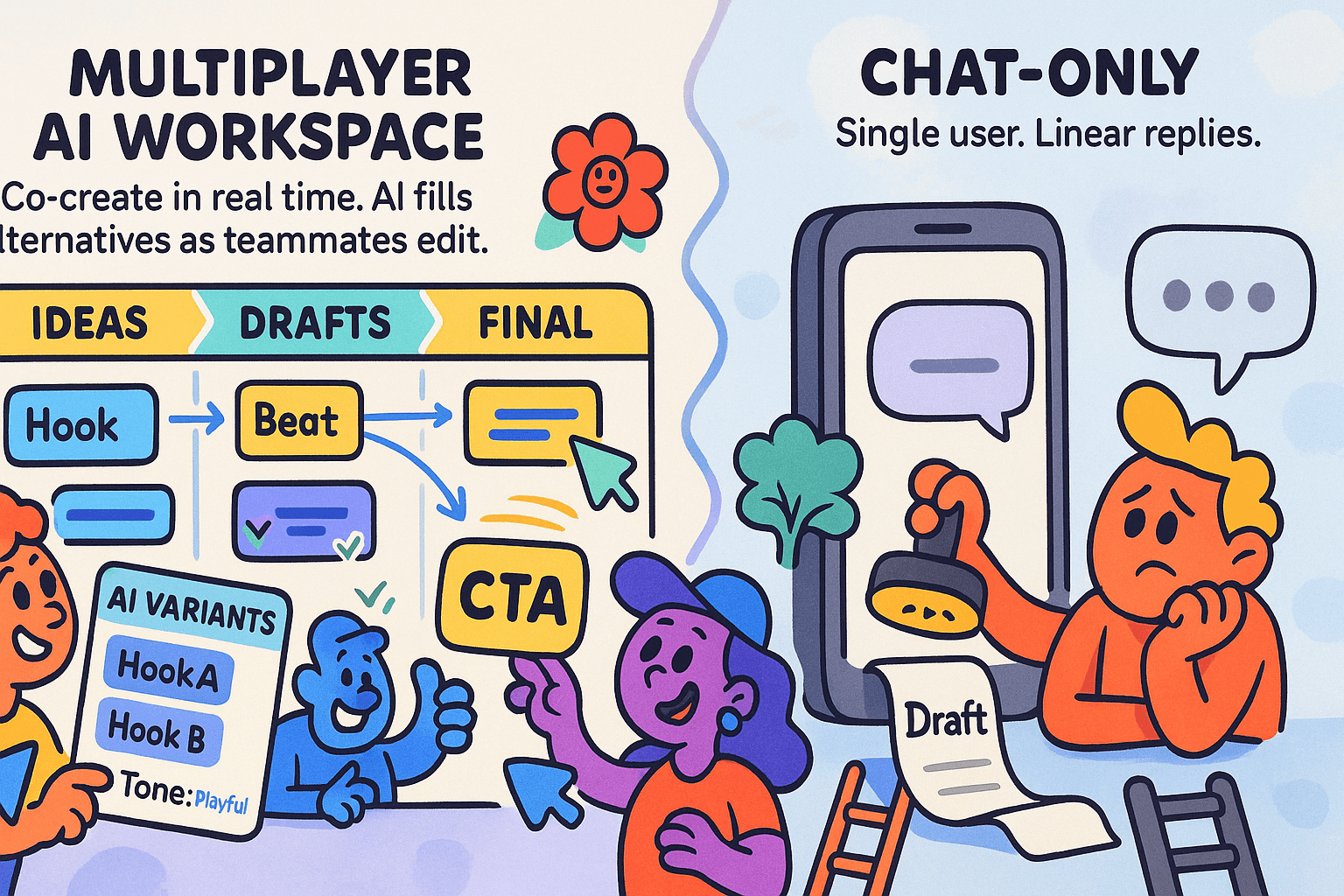
Templates and typical outputs
The vendor blog catalogs task-specific templates: YouTube scripts, sales pages, email sequences, and more. In practice, assistants can spin up outlines, caption banks, hooks, and ad copy, then thread approvals in one space.
Tutorial videos show creators scripting large volumes quickly by iterating inside the canvas. Use templates as starting points and personalize before publishing.
Before/after (caption bank).
Before: one caption, many edits.
After: one prompt spawns 10 variants, you mark two “on-brand,” and archive the rest for testing.
Limits and learning curve
Expect a learning curve around credit consumption and prompt structure. Heavy repurposing, long drafts, or frequent regenerations can consume credits quickly, so teams should standardize a small set of prompts and review passes.
Start within the 30-day refund window and track which actions deliver publish-ready output versus those needing edits. For guidance, use the platform’s tutorials and workflow posts to refine your system.
Workflow playbooks for SMB content ops
Speed comes from repeatable rhythms. Use a weekly sprint to generate, a monthly calendar to pace, and a repurpose lane to multiply reach. Keep edits tight and schedule them in batches to protect focus. – Social Media Dashboard
7-day content sprint
Day 1: Gather raw materials. Pull last week’s analytics, FAQs from support, and one customer story.
Day 2: Ideate 10 hooks and 5 angles. Shortlist three.
Day 3: Draft one pillar piece plus caption bank. Use AI to generate first drafts, then edit for tone.
Day 4: Design thumbnails or social visuals.
Day 5: Schedule next week’s posts and UTMs. Hootsuite’s calendar process shows how to batch and preview across networks.
Day 6: Repurpose snippets into Shorts/Reels copy.
Day 7: Review results and log learnings.
Quick guardrail: cap AI time per draft and move to human edits to avoid infinite regenerations. The cost advantage of AI is real, but quality still hinges on the review pass.
30-day calendar build
Week 1: Plan themes and campaigns in a monthly grid. Use a template to assign owners, due dates, and assets.
Week 2: Create pillar content for each theme.
Week 3: Fill platform-specific variants and CTAs. Hootsuite’s calendar guide shows how teams coordinate timing and consistency.
Week 4: Buffer a “reactive” slot for timely posts and run a light retro.
Tooling note: most SMBs start with a free sheet and upgrade to schedulers as volume grows; TechRadar’s 2025 roundup compares options if you outgrow spreadsheets.
Repurpose a video to blog, shorts, and captions
Flow: pick one 5–10 minute video → extract beats and quotes → draft blog outline → pull 3 hooks → script 3 Shorts/Reels with captions.
AI speeds beat extraction and caption variations; creators document turning one piece into dozens of posts using this pattern.
If you want video-first from text, tools like Pictory can convert articles or PDFs into short videos for TikTok, Reels, or YouTube Shorts, which fits a “one source, many assets” system.
Test output and replace robotic voiceovers as needed.
Teams using Poppy specifically can run this inside a shared canvas and co-edit drafts in real time while keeping hooks, captions, and scripts together. Tutorials demonstrate the end-to-end workflow.
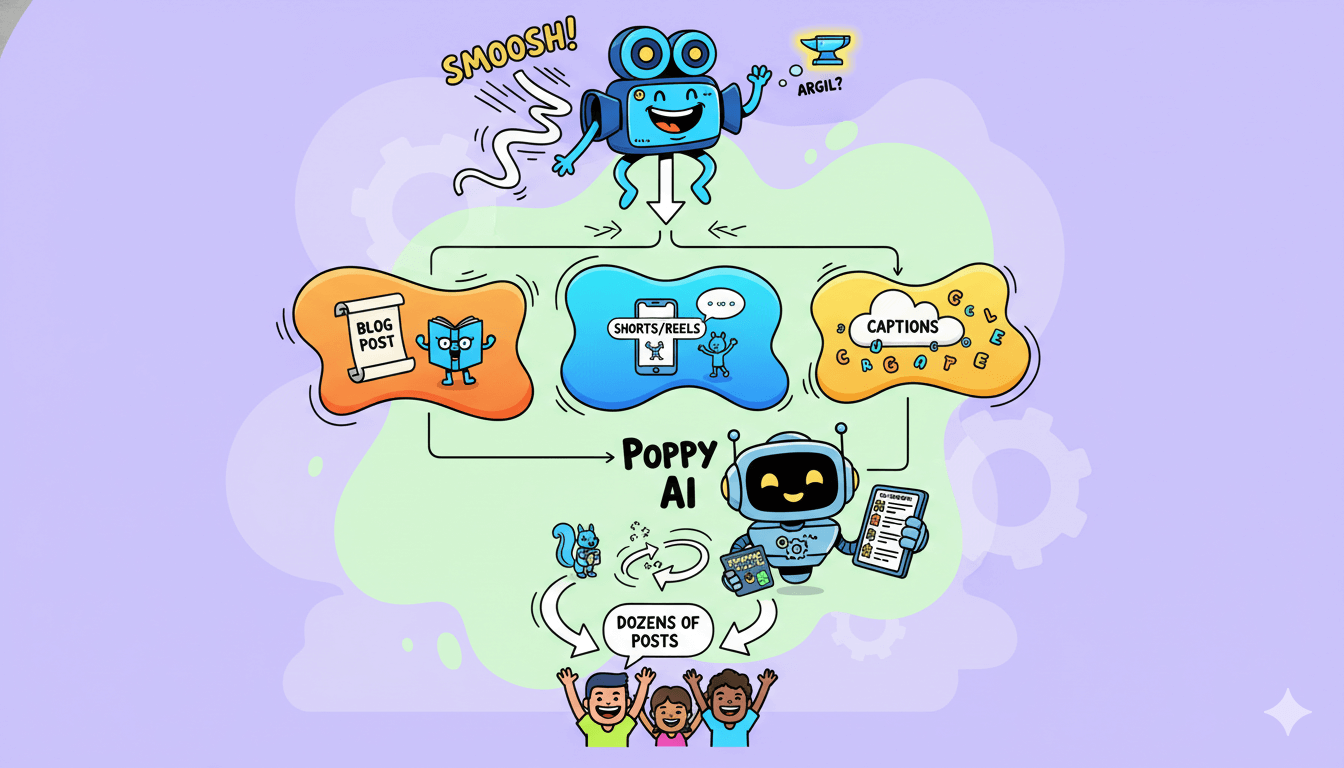
ROI math and calculator spec
AI should earn its keep on paper first. Start with two anchors: recent benchmarking shows AI-assisted posts average about $131 while human-written posts average about $611—roughly 4.7× cheaper.
Teams using AI report paying about $188/month on AI tools, which is small relative to labor deltas, so the breakeven usually hinges on volume and edit time.
Cost per post benchmarks
Use conservative assumptions. For AI, include subscription fees, estimated credit burn, and a human edit pass. For human-only, include writer fee plus manager time for briefs and edits.
As a planning anchor, plug $131/post (AI) and $611/post (human) into your first scenario, then adjust once you have your own month of data.
These figures come from 2025 surveys and are appropriate as directional starting points, not guarantees.
Break-even scenarios by volume and credits
Define your monthly content target—say 8, 16, or 30 posts. Multiply posts by each per-post cost to see raw spend. Then add tool overheads such as Poppy plus any scheduler or design tools.
If you use Poppy, monitor credit consumption during a pilot because heavier repurposing or long drafts can raise effective cost per post; third-party reviews and
…community reports note monthly credit caps that may force upgrades if you’re producing at scale.
Micro-challenge. Pick next month’s target posts and run both totals now. If the AI route is cheaper by at least 25% after edits, proceed to a 30-day trial and validate with your own outputs.
Sensitivity: edits and QA time
Quality lives in the review pass. Add a realistic edit allowance—often 15–30 minutes per short post and 30–60 minutes for long-form—so your AI numbers don’t assume perfect first drafts.
Mark any piece requiring heavy rewrites, then update your average after the pilot.
Most teams in 2025 report keeping human review in place even when they scale AI output, which is consistent with the cost study’s framing and usage reports. – Ahrefs
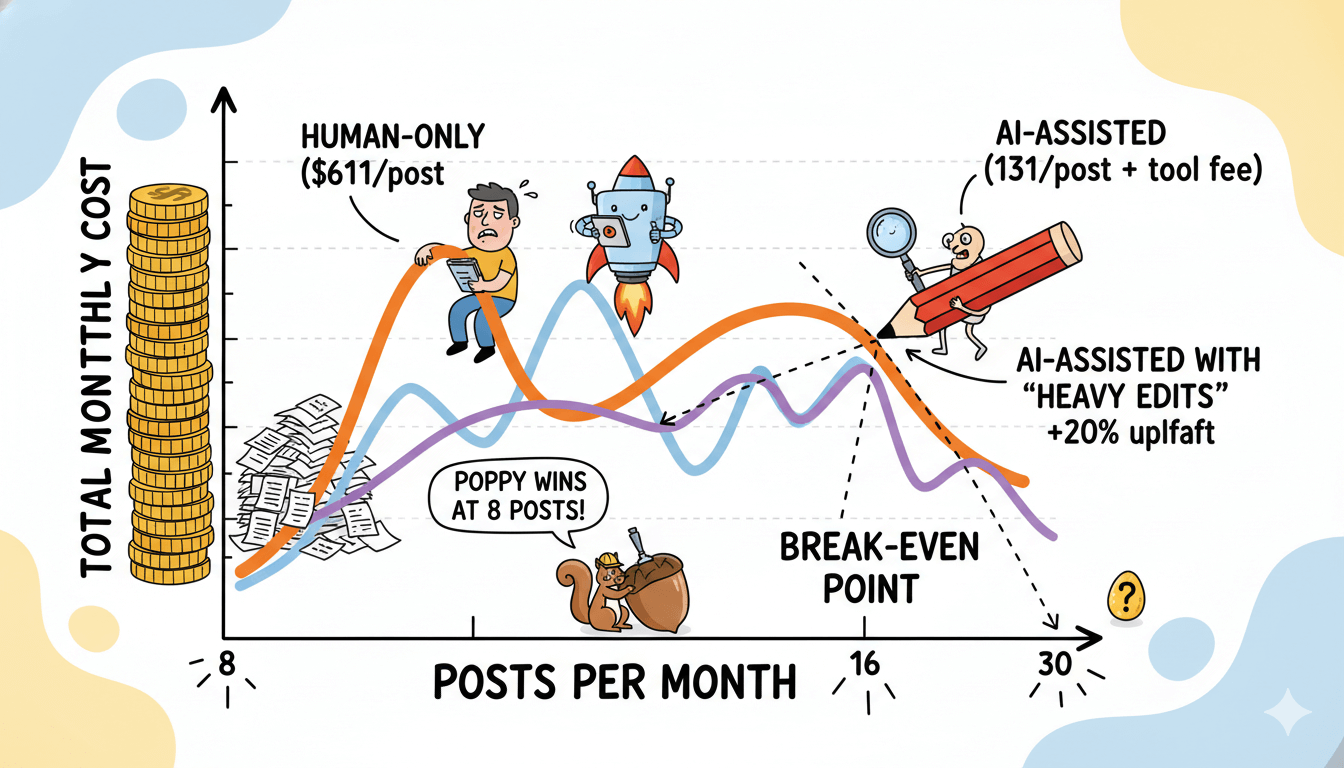
Hybrid model: where humans stay in the loop
AI can draft fast, but trustworthy marketing still runs on judgment. Keep people in charge of voice, factual claims, and relationships, then let AI handle volume work like ideation, first drafts, summaries, and post variants.
That split mirrors how assistant roles are scoped: execution support under a manager’s guidance.
Human checkpoints
Add explicit gates before anything ships. Voice and tone: final pass by a human editor to ensure it sounds like you. Claims and compliance: verify stats, sources, and product promises against approved references.
Context and nuance: handle stakeholder emails, partnerships, and community replies person-to-person.
These duties map to common assistant descriptions that emphasize reporting, event coordination, and cross-team support under supervision.
When to escalate to a specialist
Escalate when stakes rise or novelty is high. Examples: paid ads with significant spend, PR statements, crisis responses, conversion copy on flagship pages, and partner or influencer negotiations.
Research from Harvard Business School notes that AI struggles to distinguish great from mediocre ideas; creative direction and risk trade-offs remain human calls. – Harvard Business School
Quality guardrails
Use short, consistent workflows to keep AI savings without quality drift.
First, scope the brief tightly and generate in smaller chunks to reduce credit burn and hallucinations.
Second, instrument a human review pass on every asset; most teams still do this even as they scale AI output.
Third, document acceptance criteria: what “on-brand” means, which facts are canonical, and where legal review is required.
Audience discussions echo this pattern—marketers celebrate speed but report mixed outcomes when human review is skipped.
Bottom line. Replace hours, not judgment. Let AI cover repetitive work and repurposing, then keep people on choices that affect trust, safety, and relationships. This preserves the cost advantages shown in recent benchmarks while protecting brand equity and results.
Alternatives and stack fit
Pick tools by job, not hype. Your stack should cover planning, creation, scheduling, and analytics with the fewest moving parts possible.
Start with a scheduler that centralizes calendars and reporting, then add AI where it trims hours in drafting or repurposing.
TechRadar’s 2025 roundups show mature options for calendars and social management that small teams can run without a dedicated ops hire. – TechRadar
Tool types to compare
Schedulers and calendars. Platforms like Hootsuite, Sprout, or similar tools bundle publishing, calendar views, and reporting. They now ship AI helpers for captions and ideas, which reduces first-draft time without changing the approval flow. Use these when you need consistent cross-network scheduling and performance tracking.
AI content planners. If you want the calendar to suggest topics or slot posts automatically, shortlists from recent calendar tool reviews are useful starting points for SMBs evaluating “AI-powered” planners.
Validate claims with a one-month trial.
Repurpose and creative apps. When your workload is video-first, pair a scheduler with a repurpose tool or a canvas-style AI.
Poppy’s “multiplayer” format is one approach; Microsoft’s Copilot Pages is another enterprise-leaning take on collaborative AI workspaces. Choose based on where collaboration actually happens in your team.
Marketplace “alternatives.” Comparison portals list creation suites like Simplified, Jasper, Canva, and others. Treat these as directories, then test against your exact workflow and export needs before switching.
When Poppy is overkill
If you publish a handful of posts a week on one or two networks and rarely run multi-stakeholder reviews, a classic scheduler with a light AI writer is usually enough.
TechRadar and independent lists emphasize that mature social tools already cover calendar, publishing, inbox, and analytics with new AI assist layers for ideation and captions.
That stack is cheaper and simpler to train than a full collaborative canvas.
Migration path and data hygiene
Pilot with a 30-day test: freeze your existing calendar, mirror it in the new tool, and compare publish rate, edit time, and engagement. Keep exports portable: CSV calendar exports, media libraries, prompt packs, and caption banks.
If you move toward a collaborative AI workspace, document who approves what and where source-of-truth lives so content does not fragment across boards and schedulers.
Hootsuite’s guides on AI use in social planning are useful for defining roles, prompts, and reporting baselines that survive tool changes.
Before/after (stack fit).
Before: separate docs, ad-hoc prompts, manual scheduling.
After: one scheduler with AI captioning plus a focused canvas for complex campaigns, both tied to a single calendar export.
Buyer checklist and 14-day pilot plan
Run a short, instrumented trial. Decide based on outputs, edit time, and total cost, not hype. Lock success criteria on day one and capture credit usage so your numbers travel.
Must-have criteria
- Refund terms you can comply with. Poppy offers a 30-day money-back guarantee that requires you to book and attend an onboarding call during the window; otherwise refunds are ineligible. There is no free trial listed on the site. Save confirmation emails and calendar receipts.
- Credit model clarity. Pricing pages are light on caps. Reputable reviews report ~1,000 credits/month on a common plan and “actions” consuming credits; some community posts mention ~2,000 credits on higher tiers. Treat these as directional until checkout. – Meredith Marsh
- Collaboration fit. Poppy’s pitch is a visual, “multiplayer” AI canvas. If most work happens in shared boards with many reviewers, this matters. If your flow is solo drafting plus a scheduler, a simpler tool may suffice.
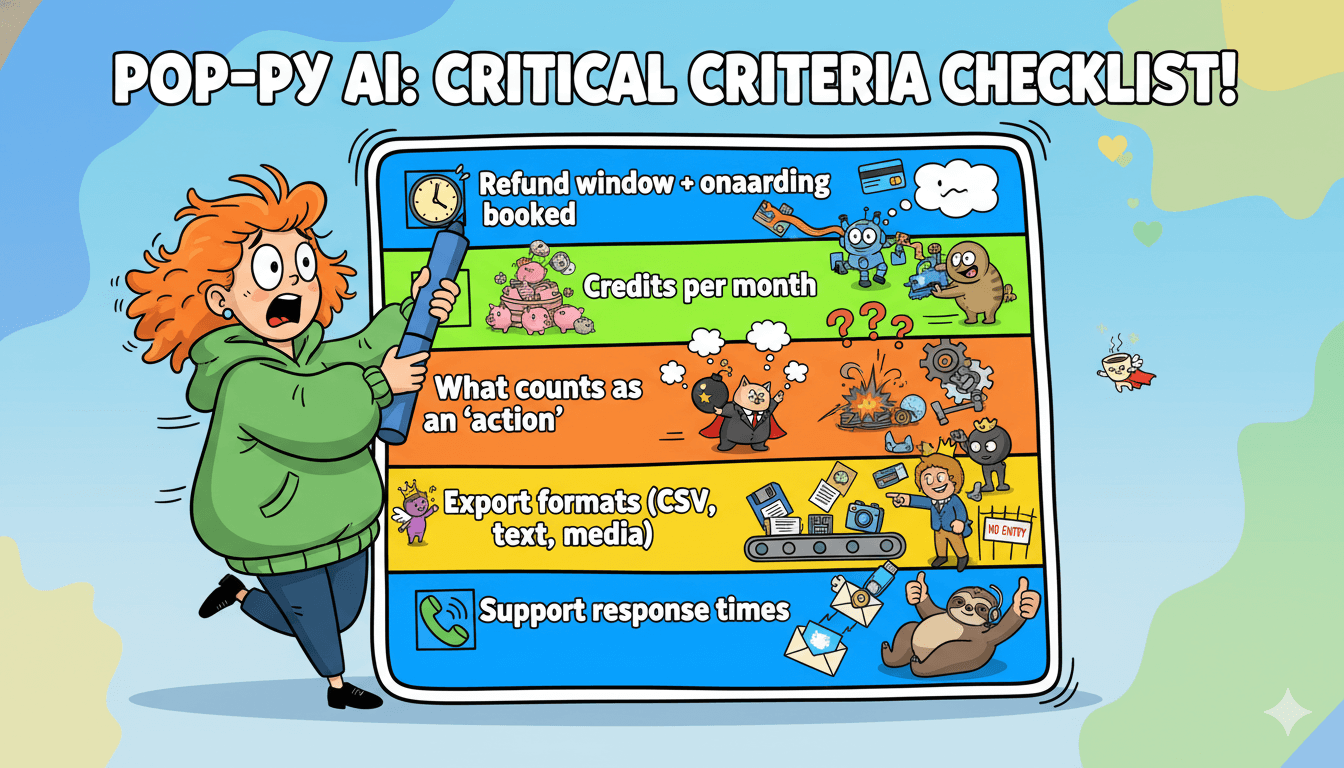
Simple pilot plan
Week 1.
- Book the onboarding call immediately to preserve refund eligibility.
- Import one campaign brief, one pillar video, and last month’s calendar.
- Standardize three prompts: ideation, repurpose, caption variants.
- Start a credit log: date, artifact, actions, credits consumed.
Week 2.
- Produce a mini set: one blog or script, three Shorts/Reels scripts, ten captions.
- Time each human edit pass. Mark assets that needed heavy rewrites.
- Compare publish rate and edit minutes to last month’s baseline.
Decision. Keep if the pilot shows lower cost per asset and equal or better quality at your edit bar; otherwise cancel within the guarantee window. Document the cancel path and deadlines.
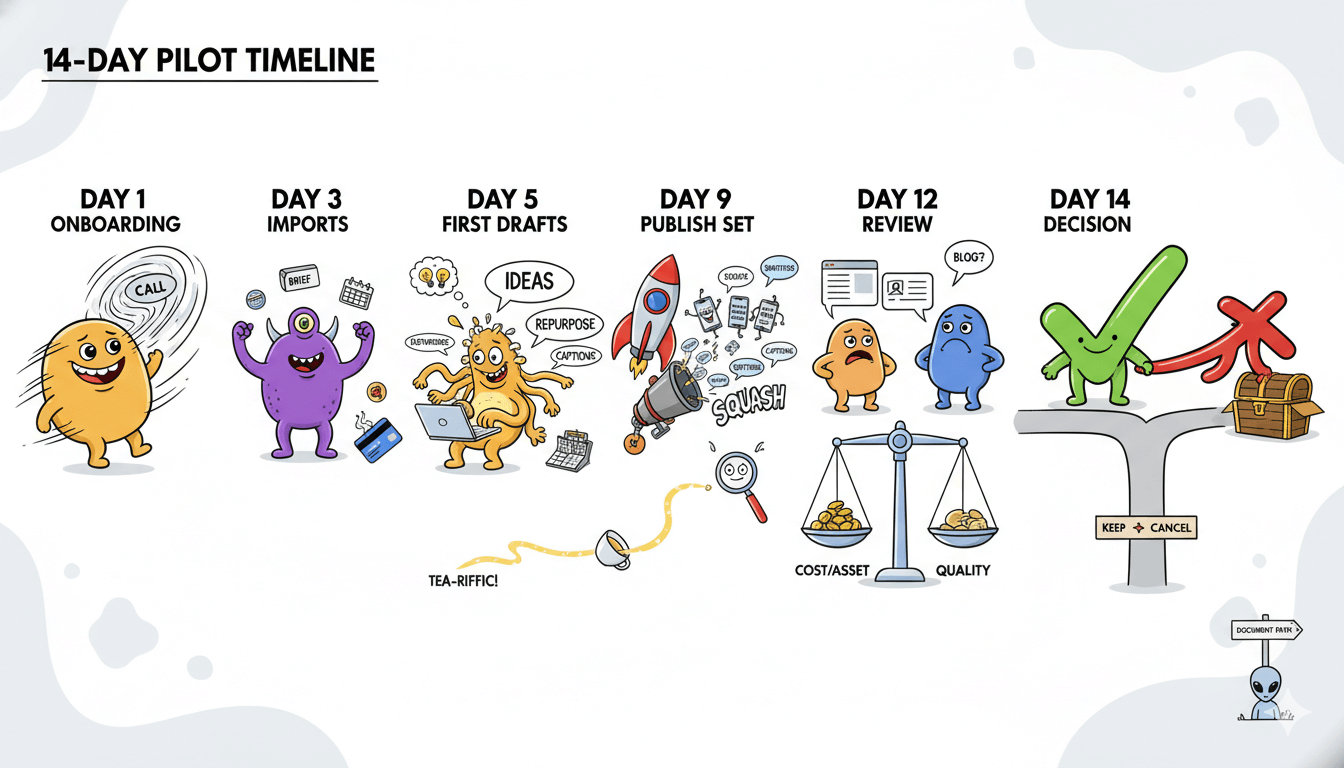
Data and privacy notes
Audit exports and storage. Confirm you can export prompts, caption banks, and calendars without loss. Keep a single source-of-truth calendar to avoid version drift if you also use a scheduler.
For risk control, store references for claims you publish and note who approved each asset. If refund disputes arise, third-party sites advise recording support interactions, though the binding terms remain Poppy’s policy page.
Pro tip. Put your refund deadline and onboarding call on the team calendar the day you subscribe. It protects the guarantee while you test credit burn and collaboration fit.
Conclusion
Here is the practical answer. Poppy can cover a large slice of junior assistant output for far less money. Current U.S. benchmarks put a marketing assistant near $3.5k–$3.8k per month, depending on source and location.
That is your baseline to beat.
AI shifts the math in your favor. Recent data shows an average $131 per AI-assisted post vs $611 per human-written post.
Even after you add a sensible edit pass and a modest AI tool budget, the gap remains meaningful… especially at 8, 16, or 30 posts per month. Use a simple calculator and your own 30-day sample to confirm.
Where does Poppy fit. It gives you a shared canvas for ideation, drafting, and repurposing with a clear promise you can test: a 30-day money-back guarantee.
Book the onboarding call, run a tight two-week pilot, and track credit burn against outputs and edit time. Keep what proves faster and cheaper at your quality bar. Cancel if it does not.
What still needs people. Voice, approvals, claims, and relationships. Treat AI as the engine that moves content forward and humans as the brakes and steering. That hybrid gives you speed without losing trust.
Final cue. Set one month on the calendar. Log every draft, edit, and action. Compare total cost against the assistant baseline.
If your real numbers show lower spend with equal or better quality, you have your answer… and a repeatable system to scale next month.

Poppy Ai: The fastest way to fill your content calendar




